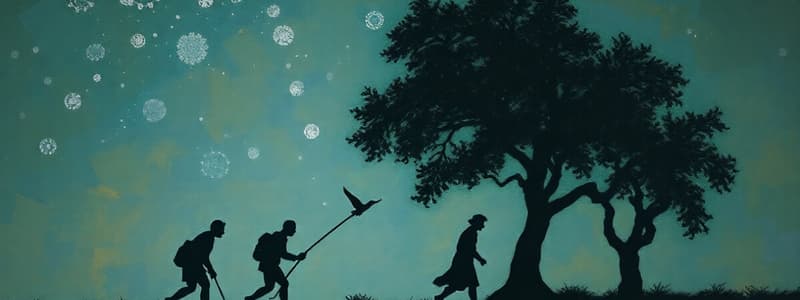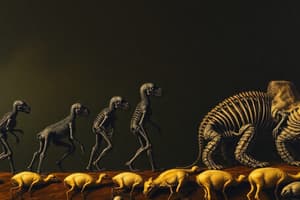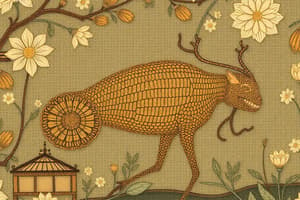Podcast
Questions and Answers
Which line of evidence for descent from a common ancestor is most closely related to the concept of homology?
Which line of evidence for descent from a common ancestor is most closely related to the concept of homology?
- Comparative anatomy (correct)
- Fossil record
- Biogeography
- Embryology
In sedimentary rock layers, which statement accurately describes the relationship between the age of fossils and the strata?
In sedimentary rock layers, which statement accurately describes the relationship between the age of fossils and the strata?
- Younger fossils are found in deeper strata.
- Older fossils are found in shallower strata.
- Older fossils are found in deeper strata. (correct)
- Fossil age is independent of strata depth.
Why is the shared genetic code (DNA, RNA, and protein synthesis mechanisms) of all life on Earth considered a homology?
Why is the shared genetic code (DNA, RNA, and protein synthesis mechanisms) of all life on Earth considered a homology?
- It indicates convergent evolution across distantly related species.
- It demonstrates the independent development of similar biochemical pathways.
- It is a result of horizontal gene transfer between unrelated organisms.
- It points to a common ancestral origin for all life. (correct)
What observation would challenge the concept of hierarchical organization in living organisms?
What observation would challenge the concept of hierarchical organization in living organisms?
In the context of natural selection, how is 'fitness' best defined?
In the context of natural selection, how is 'fitness' best defined?
Which situation exemplifies adaptation?
Which situation exemplifies adaptation?
What role does mutation play in natural selection?
What role does mutation play in natural selection?
How does allopatric speciation occur?
How does allopatric speciation occur?
Which pre-zygotic reproductive isolation mechanism is characterized by different mating behaviors?
Which pre-zygotic reproductive isolation mechanism is characterized by different mating behaviors?
What is the outcome of hybrid sterility, a post-zygotic reproductive barrier?
What is the outcome of hybrid sterility, a post-zygotic reproductive barrier?
What does a node represent on a phylogenetic tree?
What does a node represent on a phylogenetic tree?
When constructing a phylogenetic tree, why is it important to use many characters (traits)?
When constructing a phylogenetic tree, why is it important to use many characters (traits)?
How do mutation rates and fossil ages contribute to calibrating a molecular clock?
How do mutation rates and fossil ages contribute to calibrating a molecular clock?
What is the significance of the great oxygenation event (GOE) in the history of life on Earth?
What is the significance of the great oxygenation event (GOE) in the history of life on Earth?
What is the role of endosymbiosis in the rise of eukaryotes?
What is the role of endosymbiosis in the rise of eukaryotes?
What is the nutritional mode of fungi?
What is the nutritional mode of fungi?
What distinguishes Kingdom Animalia from other kingdoms?
What distinguishes Kingdom Animalia from other kingdoms?
Which evolutionary innovation is associated with the success of amniotes in terrestrial environments?
Which evolutionary innovation is associated with the success of amniotes in terrestrial environments?
In photosynthesis, what is the role of the thylakoid membrane?
In photosynthesis, what is the role of the thylakoid membrane?
What role do guard cells play in plant physiology?
What role do guard cells play in plant physiology?
Flashcards
Natural Selection
Natural Selection
Organisms with advantageous traits survive and reproduce more successfully.
Descent with Modification
Descent with Modification
Over generations, species change as traits are passed down and modified.
Comparative Anatomy (Homology)
Comparative Anatomy (Homology)
Structures in different species that are similar due to shared ancestry.
Embryology
Embryology
Signup and view all the flashcards
Genetic Evidence
Genetic Evidence
Signup and view all the flashcards
Biogeography
Biogeography
Signup and view all the flashcards
Fossil
Fossil
Signup and view all the flashcards
Strata
Strata
Signup and view all the flashcards
Origination
Origination
Signup and view all the flashcards
Extinction
Extinction
Signup and view all the flashcards
Vestigial Structures
Vestigial Structures
Signup and view all the flashcards
Fitness
Fitness
Signup and view all the flashcards
Adaptation
Adaptation
Signup and view all the flashcards
Acclimation
Acclimation
Signup and view all the flashcards
Adaptation
Adaptation
Signup and view all the flashcards
Biological Species Concept
Biological Species Concept
Signup and view all the flashcards
Adaptive Radiation
Adaptive Radiation
Signup and view all the flashcards
Sexual Selection
Sexual Selection
Signup and view all the flashcards
Phylogenetic Tree
Phylogenetic Tree
Signup and view all the flashcards
Principle of Parsimony
Principle of Parsimony
Signup and view all the flashcards
Study Notes
Descent with Modification
- Darwinian evolution comprises natural selection and descent with modification
- Natural selection results in organisms with advantageous traits surviving and reproducing more successfully
- Descent with modification leads to species changing over generations as traits are passed down and modified
- Five lines of evidence support descent from a common ancestor:
- Fossil record shows transitional forms and changes over time
- Comparative anatomy (homology) reveals similar structures in different species due to shared ancestry
- Embryology indicates early developmental similarities suggest a common origin
- Genetic evidence shows DNA similarities indicate evolutionary relationships
- Biogeography indicates geographic distribution of species supports common descent
- Homologous structures provide evidence supporting fossil records, embryological similarities, genetic evidence, and geographical distribution
- A fossil is a preserved remain, impression, or trace of ancient life typically found in sedimentary rocks
- Strata are layers of sedimentary rock
- Older fossils are found in deeper strata, aiding in the dating of evolutionary events
- Origination is the process by which a new species evolves
- Extinction is the complete disappearance of a species from Earth
- The shared genetic code (DNA, RNA, and protein synthesis mechanisms) of all life points to a common ancestral origin
- Life is organized in nested groups
Hierarchical Organization of Life
- Domain is the broadest category, followed by kingdom, phylum, class, order, family, genus, and species
- A hierarchical organization means species fit into nested groups, displaying a clear evolutionary pattern in trait distribution
- Organisms from a shared geographic area are closely related due to a recent common ancestor that has adapted to that region
- Vestigial structures are reduced or non-functional structures inherited from ancestors
Natural Selection
- Fitness is an organism's ability to survive and reproduce in its environment
- Genes code for traits
- Traits are characteristics shaped by genes that affect survival/reproduction
- Phenotype refers to observable traits influenced by genes and the environment
- Survival and reproduction are greater with higher fitness
- Adaptation is a heritable trait that enhances an organism's fitness in a specific environment and increases survival and reproductive success
- Natural selection requires:
- Variation, where individuals in a population differ in traits
- Heritability, where traits are genetically passed down
- Differential reproduction, where advantageous traits lead to increased reproduction
- Acclimation is a temporary physiological change in response to the environment, while adaptation is a permanent genetic change over generations in response to natural selection
Adaptations and Species
- Adaptations evolve due to environmental pressures, with traits beneficial in one environment becoming harmful in another
- Mutations introduce genetic variation, creating new traits acted on by natural selection
- The biological species concept defines a species as a group of organisms capable of interbreeding and producing viable, fertile offspring
- Allopatric speciation involves:
- Geographic isolation separating a population
- Different selection pressures pushing evolutionary changes
- Reproductive isolation eventually preventing interbreeding
- Pre-zygotic reproductive isolation happens before fertilization:
- Temporal isolation: mating at different times
- Behavioral isolation: different mating behaviors
- Mechanical isolation: incompatible reproductive structures
- Gametic isolation: sperm and egg fail to fuse
- Post-zygotic reproductive isolation happens after fertilization:
- Hybrid inviability: offspring won’t develop properly
- Hybrid sterility: offspring are sterile
- Hybrid breakdown: hybrid offspring are weak or infertile
- Adaptive radiation is the rapid diversification of a lineage into varied species adapted to different environments
- Traits that raise reproductive success, such as mate preference or competition, evolve through sexual selection
- Evolutionary trade-offs are traits enhancing fitness but also have downsides
Phylogeny and Tree Thinking
- A phylogenetic tree shows proposed relationships among species based on shared ancestry, revised with new data
- Phylogenetic trees depict common ancestry and divergence
- Linnaean hierarchy organizes species into nested taxonomic ranks and both methods classify by evolutionary relationships
- Yes, with phylogenetic trees, it can differ from a Linnean hierarchy because Linnaean classifications were originally based on morphology, which can be misleading
- Not all Linnean groupings are monophyletic, for example, reptiles including birds, are paraphyletic
- Nodes on a phylogeny show the most recent common ancestor of descendant species
- Branching points show speciation events as lineages split in two
- Speciation is linked to the biological species concept as it occurs when reproductive isolation evolves, preventing gene flow
- Homology indicates similar traits due to shared ancestry
- Analogy indicates similar traits due to convergent evolution, not common ancestry
- Homoplasy describes traits that appear similar but evolved independently, potentially through convergence
- Homologous traits infer evolutionary relationships
- Parsimony states the simplest explanation via the fewest evolutionary changes is more likely correct
Phylogenetic Tree Interpretation
- Find the most recent common ancestor (MRCA) at the node where taxa share a branch
- Taxa that share a more recent MRCA are more closely related
- The outgroup/basal taxon is the earliest diverging lineage on a tree
- Recognize monophyletic, paraphyletic, and polyphyletic groups:
- Monophyletic group: ancestor and all its descendants
- Paraphyletic group: ancestor but not all descendants
- Polyphyletic group: members from different ancestors
- Polytomies indicate unresolved branches or uncertain evolutionary relationships
- Evolutionary events shown by tick marks describe tip or node characteristics, such as feather, fur, or limb quantity
- Convergent evolution indicates different lineages that independently develop similar traits
Phylogenies and Data
- Determine which trees show the same evolutionary relationships
- Map evolutionary events (trait changes) using tick marks
- Find the most parsimonious tree by mapping evolutionary events
- The most parsimonious tree shows the fewest evolutionary changes
- Phylogenetic trees should use many characters to avoid misleading signals from convergent evolution and improve accuracy with independent data points
- Mutation rates provide a timeline and fossil ages which estimates absolute time to calibrate a molecular clock
- Molecular clocks assume mutation rates are constant and fossil records accurately reflect divergence times
- Varying mutation rates can skew divergence estimates, while missing fossils lead to branch length miscalculation
Bacteria and Bacterial Diversity
- Domain Archaea is more closely related to Domain Eukarya than to Domain Bacteria based on genetic and evolutionary evidence
- Domain Bacteria is the outgroup as it diverged first from the common ancestor of all life
- RNA was likely the genetic material in early organisms
- The RNA world hypothesis states RNA could store genetic information and catalyze reactions before DNA and proteins evolved
- Prokaryotes use energy and carbon from:
- Phototrophs use light energy
- Chemotrophs use chemical energy from inorganic or organic molecules
- Autotrophs use CO2 as carbon
- Heterotrophs obtain carbon from organic molecules
- Photosynthesis possibly evolved in bacteria ~2.5-3.5 billion years ago
- The evolution of photosynthesis changed atmospheric composition
- This led to the great oxygenation event (GOE)
Bacterial Genetic Transfer, Protists
- The great oxygenation event accumulated oxygen allowing the evolution of aerobic life
- The great oxygenation event also caused mass extinction of anaerobic organisms
- Conjugation is direct genetic transfer (plasmid) via pili for antibiotic resistance spread
- Transformation is uptake of naked DNA for genetic diversity. Genetic diversity is important for a species to survive and reproduce.
- Transduction is virus (bacteriophage) transfer of bacterial DNA for species gene transfer
- Domain Eukarya includes the eukaryotes
Protist Diversity
- Eukaryotes include protists, plants, fungi and animals
- They have cells with a nucleus and membrane-bound organelles
- Protists are eukaryotic
- Eukaryotic cells evolved from prokaryotic ancestors
- This is according to the endosymbiotic theory via complex, energy-efficient eukaryotic cells
- Mitochondria originated as engulfed ancestral aerobic bacterium
- Chloroplasts came from engulfed ancestral photosynthetic cyanobacterium
- Instead, they are nested within the eukaryotic tree
- No, plants, animals and fungi are not a sister taxon, but are paraphyletic and more closely related to various protists, plants, animals, and fungi
- Animals and fungi are closest relatives, plants are separate
- Multicellularity independently evolved multiple times in six eukaryote lines
Fungi Diversity
- Ascomycota is sac fungi for yeast, molds, and morels and spores in asci
- Basidiomycota is club fungi for mushrooms, puffballs, and shelf fungi and spores in basidia
- Fungi are animals than plants because all fungi and animals belong and share a opsithokonta clade
- A distinct common ancestor does exist
- Fungi is absorptive heterotrophic decomposers that secrete to digest and absorb nutrients
- Hyphae are fungal filaments that increase nutrient absorption surface
- Networks forms that infiltrates food
- Fungi reproduce asexually (spores, budding, fragmentation) and sexually with hyphae fusion from other individuals
- Plasmogamy is cytoplasm fusion into heterokaryotic/dikaryotic cells
- Karyogamy is nuclei fusion into diploid zygotes
- Fungi are important to ecosystems as decomposers, symbionts, and pathogens
- Fungi also aid in food production via fermentation
- Lichen is symbiosis between the ascomycota fungi, algae, or cyanobacteria
- Mycorrhizae is mutualism that aids plant roots for nutrient absorption
Animal Diversity
- Kingdom Animalia are multicellular and heterotrophic and lack cells walls. Metazoa include all animals including sponges. Eumetazoa are all animals besides sponges with true tissues
- Bilaterians have bilateralism, symmetry and three germ layers
- Deuterostomes have mouth derived from the blastopore. Includes chordates and echinoderms
- Chordates feature the nerve cord for pharyngeal slits and tail
- Vertebrates have backs for chordates
- Aminotes are verebrates and have a aminotic egg for reproduction from water (reptiles, birds, and mammals)
- Mammals have milk and hair
- Monotromes include egg laying platypus, echidna
- Marsupials are mammals and have early developed kangaroos, koalas
- Eutherians includes mammala that develop placenta with gestation that includes humans, dogs ,and whales
- Primates include placental with hands, eyes, and brains that includes monkeys, apes, and humans
- bony fish and lobe-finned fish are included
- Lobe finned fish is for the ancestor in the amphibiams and tetrapods
- Amphibians are vertebrates
- Notochord came first in chordates with vertebrae that appeared in vertebrates with the jaws in gnathostomes
- Lobe0finned fishes came first that had precursors for limbs
- Limbs with digits came in tetrapods amphibians, mammals and birds in amniotes that can reproduce on land
- Chordates have notochord and the dorsal hollow nerve cord
- Amphibians include moist skin and metamorphosis for cold blood in environments and eggs
Amniotes and Photosynthesis
- Amniotes are successful for eggs, less water loss
- Internal fertilization for survival
- Birds are theropod dinosaurs and closest relative for archosauria
- Diversity change over time and many animals
- Only homosapiens for evolution with support and transport that changed the carbon cycle
- Products of light reactions
- Sunlight, water, nadp, and adp
- Calvin Cycle has c02 as atmosphere
- G3p is sugar that is a part of reactions
- Tylakoid allows membrane
Cellular Respiration
- Photosystem I and etc facilitate movement.
- There is a separation between etc and stromna
- Glucose is photosynthesis
- There is cellular respiration because there are components that is the basis of the cycles for life
- Water splitting at the photosystem chain of h cycles
- H uses thylakoid ATP
- Carbon fixation is to inorganic, occurring in the stroma while fixing to rubp
Plant Anatomy
- Roots anchors and shoots transport with leaves that exchange nutrients
- Tissues aid what the function with 3 terms
- Dermis protects with vascular
- Parenchyma has photosynthesis
- Selctive Endoderma barriers regulated through the vascular
- Strip contains water regulation
Osmotic Pressure
- Water has a osmotic that allows the membrane
- Bulk flows the xylem
- Targid maintains
- Water transports pressure is the transpitation for plants
- cohesion transports it
- Pathways move that move cells
- Preforatiom allows movement
- Pholem has controled
- Pholiem transport in the cell with dead tissue
- Turgid swell gaurd open
- Meristems allow for stems
Studying That Suits You
Use AI to generate personalized quizzes and flashcards to suit your learning preferences.




